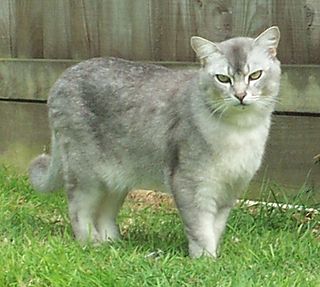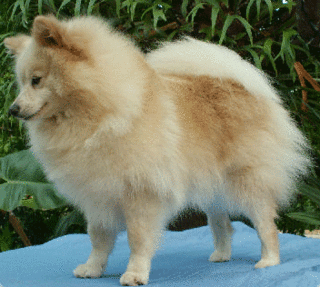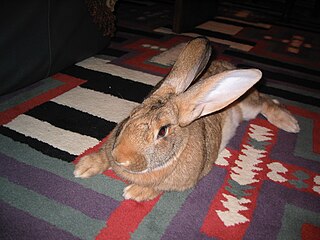
The British Giant rabbit is a larger rabbit that has its heritage in the Flemish Giant, a breed that originates in Belgium. The British Giant can grow up to 7 kg and often rivals a small dog in size. [1]

The British Giant rabbit is a larger rabbit that has its heritage in the Flemish Giant, a breed that originates in Belgium. The British Giant can grow up to 7 kg and often rivals a small dog in size. [1]
The British Giant arose as a separate breed in the United Kingdom in the 1940s and was bred from Flemish Giant stock of varying colours from the United States. The Flemish Giant breed standard in Britain is only recognised in steel grey colouring and may be somewhat smaller than the European Flemish Giant. Thus the British Giant was bred for a greater variety in colouring and although smaller than continental Flemish rabbits, retain broadly the same characteristics. The British Giant is virtually unknown outside the United Kingdom, where it is a recognised breed. [2] [3]
The biggest of all the British breeds, the British Giant has a large, powerful body that is flat across the back and has a wide front and hindquarters. Its fur is medium length, dense and soft and comes in a variety of colours including white, sable, opal, grey, blue and black. [2]

The Chinese is an international breed of domestic goose, known by this name in Europe and in North America. Unlike the majority of goose breeds, it belongs to the knob geese, which derive from Anser cygnoides and are characterised by a prominent basal knob on the upper side of the bill. It originates in China, where there are more than twenty different breeds of knob goose.

The Orpington is a British breed of chicken. It was bred in the late nineteenth century by William Cook of Orpington, at that time in Kent in south-east England. It was intended to be a dual-purpose breed, to be reared both for eggs and for meat, but soon became exclusively a show bird.

The Burmilla is a breed of domestic cat, that originated in the United Kingdom in 1981. It is a cross between the Chinchilla Persian and Burmese cats. In certain cat registries the breed falls under the Asian group, and is sometimes referred to as the Asian Shaded. Standards were produced in 1984, and the breed gained championship status in the United Kingdom in the 1990s.

The German Spitz is a breed of spitz-type dogs from Germany. It is considered a single breed, with five distinct varieties based on size and colour: the Wolfsspitz/Keeshond, the Giant Spitz or Großspitz, the Medium Spitz or Mittelspitz, the Miniature Spitz or Kleinspitz and the Pomeranian or Zwergspitz.

The Netherland Dwarf is a breed of domestic rabbit that originated in the Netherlands. Weighing 1.1–2.5 pounds (0.50–1.13 kg), the Netherland Dwarf is one of the smallest rabbit breeds. Its popularity as a pet or show rabbit may stem from its neotenic appearance. The Netherland Dwarf is recognised by both the American Rabbit Breeders Association (ARBA) and the British Rabbit Council (BRC). The Netherland Dwarf is often confused with the Polish breed of rabbit, but the latter has longer ears, a non-brachycephalic head and less cobbiness.

The Malay Game is a breed of game chicken. It is among the tallest breeds of chicken, and may stand over 90 cm high.

The Sussex is a British breed of dual-purpose chicken, reared both for its meat and for its eggs. Eight colours are recognised for both standard-sized and bantam fowl. A breed association, the Sussex Breed Club, was organised in 1903.

The Japanese Bantam or Chabo is a Japanese breed of ornamental chicken. It is a true bantam breed, meaning that it has no large fowl counterpart. It characterised by very short legs and a large upright tail that reaches much higher than the head of the bird.
Chinchilla rabbits are a group of three rabbit breeds that have been bred for a coat that resembles that of chinchillas. Despite their name, they are not related to and cannot interbreed with chinchillas, which are a species of rodent. Rabbits are lagomorphs. A mutation diluted the yellow pigment in the hairs to almost white, changing in this way the color of the fur of the wild rabbit (agouti) into chinchilla.

The Flemish Giant rabbit is the largest breed of domestic rabbit. Flemish Giants are historically a utility breed used for their fur and meat. They are often kept as pets as they are known for being docile and patient when being handled.
The French Lop is a breed of domestic rabbit developed in France in the 19th century from the selective breeding of English Lop and Flemish Giant stock. The French Lop resembles the English Lop, but the French Lop is heavier in stature and does not have the exaggerated ear length of the English Lop. Weighing approximately 4.98 kg to 5.21 kg, it has an average lifespan of five to seven years. The French Lop is currently recognized by the American Rabbit Breeders Association (ARBA) and by the British Rabbit Council (BRC).

The American Rabbit is a breed of rabbit, recognized by the American Rabbit Breeders Association (ARBA) in 1917. By the ARBA standard, American rabbits have a mandolin body shape. It has also been noted for a good 'sweet' temperament and good mothering abilities. As with all domestic rabbits, the American breed is of the species Oryctolagus cuniculus, the European wild rabbit.

The Yokohama is a German breed of fancy chicken, with unusual colouring and very long tail-feathers. It was created by Hugo du Roi in the 1880s, and derives from ornamental birds brought to Europe from Japan in the second half of the nineteenth century. Some of these were shipped from the Japanese port of Yokohama, and so were known by that name. In Germany, the Yokohama name is used only for white or red-saddled birds; in the United Kingdom, it is used also for the birds known elsewhere as Phoenix, in various colours.

The Argenté rabbit is one of the oldest breeds of French show rabbits. The British Rabbit Council (BRC) recognises six varieties: Argenté Bleu, Argenté Brun, Argenté Crème, Argenté de Champagne, Argenté Noir, and Argenté St Hubert. The American Rabbit Breeders Association (ARBA) recognises the Champagne d'Argent, the Crème d'Argent and the Argenté Brun. A rare variety, the Argenté Clair, is not currently recognised by either the BRC or ARBA.
The English Lop is a fancy breed of domestic rabbit that was developed in England in the 19th century through selective breeding. It is believed to be the first breed of lop rabbit developed by humans, and it may be one of the oldest breeds of domestic rabbit. Averaging 5.5 kg (12 lb), the English Lop is characterised by its distinctively long lop ears, bold head, and large body size.

The Blanc de Bouscat is a large white rabbit originally bred in France in 1906, with Argente Champagne, French Angora and Flemish Giant in its heritage. It is very rare in the UK and considered a breed at risk in France.

The Continental Giant, also known as the German Giant, is a very large breed of rabbit which was originally bred for meat. It is recognized by the British Rabbit Council in two categories, colored and white, but is not recognized as a breed by the American Rabbit Breeders Association.

The Miniature Lion Lop is a breed of domestic rabbit recognised by the British Rabbit Council. The breed is not currently recognized by the American Rabbit Breeders Association. In addition to its lop ears, the distinguishing feature of this breed is its Lionhead-type mane and its small size: 1.5–1.6 kilograms (3.3–3.5 lb).

The Thuringer is a breed of rabbit. It was originally known as the Thuringer Chamois due to having fur resembling that of the Chamois.They can be used for meat and fur, but make docile pets.